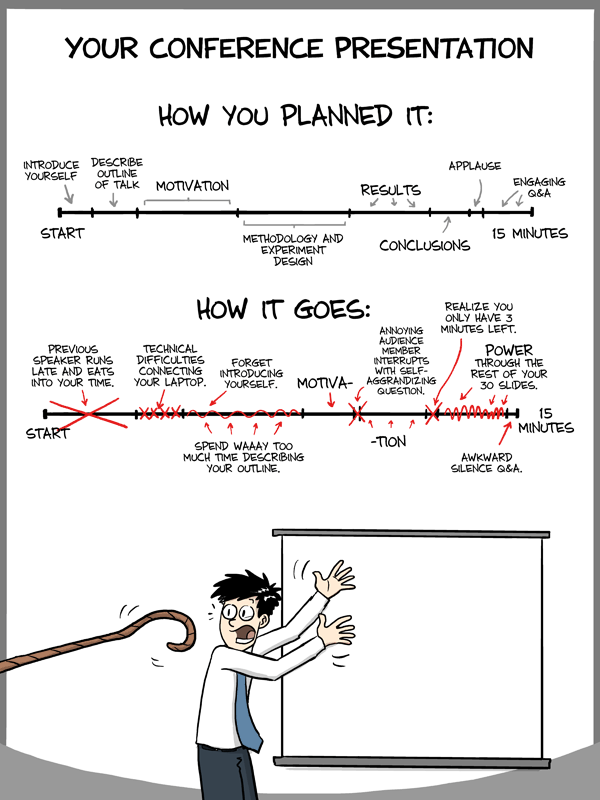Guidelines
Requisitos de finalización
General
There are different kinds of "mathematical talks", like e.g.
- scientific talks at a conference/workshop,
- mathematical lectures,
- seminar talks,
- ...
In this lecture we concentrate on scientific talks at conferences or workshops. How are conferences organized, how do they work? Note, however, that most of what we explain below is of more general nature and therefore valid for almost all kinds of talks.
Preparation of the presentation
- Prepare your presentation according to how much time you are given
- Depending on the density of the slides, plan 2-3 minutes per slide.
- Once you are more experienced, you will develop a feeling, how much content you can fit into how much time.
- As long as you do not feel experienced enough, consider rehearsing your presentation (plus check how long it really takes).
- Adapt your presentation to the background of the audience
- The audience must understand the problem/domain addressed in the talk.
- The audience must understand the language/terminology that you use in the talk.
- The audience must take home at least one core message from your talk.
- The less background the audience has, the more basic your presentation has to become.
- Think about potential questions the audience may ask and prepare your answers.
- Clarify, which equipment you will have available (beamer, blackboard, whiteboard, etc.), and develop a plan how to utilize it (note, that different equipment suits different content!).
Slides
- Recommendation: use the LaTeX "beamer" package.
- Don't try too squeeze to much material on a slide.
- In particular, don't mess with the font sizes (the defaults are reasonable, smaller fonts become unreadable).
- Choose the beamer "theme" according to the style of your institution (or according to your taste
).
- When using colors take into account that they may not be faithfully shown on the beamer.
- Choose format 4:3 (suitable for all beamers) or 16:9 (only if you are sure that is supported by beamer).
- 16:9 has longer lines but pages are less high.
- Advantage/disadvantage depends on content, e.g. if only text then 16:9 tends to have "long text lines", but if you use images then 16:9 gives more space on left/right margins.
- Make your slides easy to read i.e., structurally simple and aesthetically pleasing.
- No full paragraphs from paper.
- Short sentences/sentence skeletons as bulleted/enumerated lists.
- At most 2-3 lines per sentence, better break up into multiple sentences.
- No overflow of a sentence with just 1-2 words on the next line.
- Hide parts of slides and uncover step-by-step (matter of taste!).
- Advantage: content "develops", audience does not see things too early, you can deliver surprises, mimicks writing on blackboard.
- Disadvantage: can distract audience, last portions of content are often displayed only for a short time.
- Handouts? Printed version of the slides. Check, how dynamic content (covered/uncovered parts) appears in the printed version.
- Structure of the slide presentation
- Title page
- Title: significant but not too long (1-3 lines). Guide: Problem+Domain+Method.
- Authors (if multiple, presenter underlined)
- Affiliation
- Optional: event at which presentation is given.
- Without that, it becomes easier to "reuse" this talk for different occasions.
- Outline of the talk.
- Explanation of the problem/domain addressed in the talk.
- Explanation of the notation/vocabulary used in the talk.
- Formal definitions of the basic functions/predicates.
- In case there are no handouts, consider to write these somewhere where they are permanently available during the talk (e.g. blackboard).
- The core of the talk.
- Conclusions
- Potentially citations
- "Thank you" slide
- Better avoid it (just say "thank you" or "questions?") to keep the last important slide (conclusions) visible when answering the questions.
- Connect laptop and test beamer before the presentation session.
- Check the time when you start the presentation and remember how much time you are given.
- (If there was no introduction by a session chair) shortly introduce yourself.
- Give credit to the contributions of co-workers.
- Speak loud, in full sentences, and slowly.
- Speak freely, don't read the slides.
- Regularly check the time.
- Don't spend too much time on introduction and motivation, make sure to reach the core material in time.
- If you realize, you are behind schedule, drop (less important) material (don't start to speak faster).
- Make sure to reach the conclusions in the allocated time (typically you will be stopped after the allocated time by the session chair).
- Follow the instructions of the session chair.
- In particular, stop when you are asked to stop.
- Thank the audience for their attention.
- When answering questions
- Listen carefully to the question, wait patiently until the questioner has finished, and make sure you understand the question.
- If in doubt, ask the questioner for clarification.
- Try to answer the question.
- Don't talk about what you would like to talk but about what the questioner wants to hear.
- If you cannot answer the question, frankly say so (don't babble around and don't give knowingly a wrong answer).
- If the real answer would take too long, give a short outline of the answer, and ask the questioner for personal discussion after the presentation.
- Stay calm and patient even if the question sounds to you challenging, provoking, stupid, ...
The Talk

Última modificación: miércoles, 20 de marzo de 2019, 15:42